Three late afternoons at the weekend were spent at the local owl area. We found 5 or 6 different Barn Owls, and two Short-eared Owls which actually came into conflict. The latter was repeated on the Thursday afternoon session at least 3 times.
Barn Owl
On Tuesday we changed on a supposedly windfree morning to Paull, and for the earlier time of 9am, so I could make it back in time to get to a hospital appointment in Sheffield. When we arrived there was actually a cold wind. However, the sun soon broke through, which made a pleasant morning. For the first time for several years there was an Oystercatcher on the grassy sward, plus several Common Gulls and a Curlew. The tide was only just starting to retreat when we left the car park. There were Wigeon near the rocks smeared with seaweed, and a Redshank flew towards them, but panicked when it noticed our group.
We walked around the south western perimeter of the reserve, where we added Long-tailed Tits, a Goldcrest and on Target Lake a Little Grebe. One of the islands contained a few Wigeon and Teal, but there were fewer wildfowl than normal. There were more Wigeon on the riverbank and a drake Teal. A single Redshank was the sole member of the wader clan. It was too bright from Reedy Hide to see anything more than silhouettes, although a growling Crow led us to glimpse a Sparrowhawk.
A walk around the eastern side of the reserve added some partially concealed Bullfinches, but little else we hadn’t already encountered. We tried across the road, from which we had a confiding view of a male Kestrel. There were Black-headed Gulls, Pochard and Tufted Ducks on this lake as well as the noisy Canada Geese, whose honking we’d heard punctuating our morning. The hedgerow added 3 more male Bullfinches, plus at least one female. The morning group have attained 80 species for the term at the halfway stage, thus heading the league table.
The best sighting of the afternoon came when Les spotted something leaving the reeds to our left and launching itself across the Main Lake and heading in front of the big green hide. It was a glorious golden-hued Bittern lit up in the afternoon sunshine. The Wednesday pm group have now logged 76 species to half term.
ditto
Male Stonechat (c) 2023 Tony Robinson
When the Thursday morning group assembled on the banks of the Humber the air was teeming with Golden Plovers winking like stars in the bright sunshine. The tide was just receding, so the birds could have been returning to the estuarine mud after a sojourn in the fields, or have been spooked by a raptor. After lunch we saw a couple of Long-tailed Tits in the same area. We walked to the inlet where there were several Redshank and Teal. In the afternoon Gordon identified a Greenshank in the same area.
A walk on the Humber bank was accompanied by a whole bushful of Reed Buntings and Curlews heading towards the mudflats. There were no sightings of SEOs this time, which may have been caused by a dog walker who was 10 minutes ahead of us.
On the return journey on the road before lunch we were serenaded by an exaltation of Skylarks, whilst a flock of Yellowhammers lit up a small bush near the sheep pen. After lunch the sadly depleted group had to put up with the antics of Short-eared Owls in the same location.
In the fields left to go to seed when spotted a running Hare, and several Roe Deer. The wind felt quite strong at times - certainly more than the 12 mph forecast. In the afternoon we waited in the lee of the bank and eventually at nearly 2.25 a Barn Owl was spotted heading towards us as it hunted for prey. It was half-an-hour later before the first Short-eared Owl appeared. Soon it was joined by another and we witnessed at least 3 clashes between them as they sought to hunt for the same prey in the same habitat. As I left the site and headed home I noticed a dark mark in the field, which on checking proved to be a Short-eared Owl. I squeaked like a vole, and it stared me out. The Thursday pm scorer marked today’s session out of 10 a highly respectable 17! I'm sure his tongue was lodged firmly in his cheek. A Nuthatch would have lifted the session into the stratosphere. On reflection it was a shame that so many of the Thursday afternoon contingent were missing because of various illnesses for what must have been the best session for at least 6 years.
 On Friday strong winds were forecast, so we relocated to just up the coast to a more sheltered venue. However, the OTT parking fees were a bit of a slap in the face. There was no Nuthatch in the car park this time, but a male Bullfinch attempted to fill the gap. The old hedge had singing Song Thrush and Chaffinches tuning up, but no Yellowhammers this time. The open scrubland had at least 4 Roe Deer, which allowed us to approach quite close - they are obviously used to visitors.
On Friday strong winds were forecast, so we relocated to just up the coast to a more sheltered venue. However, the OTT parking fees were a bit of a slap in the face. There was no Nuthatch in the car park this time, but a male Bullfinch attempted to fill the gap. The old hedge had singing Song Thrush and Chaffinches tuning up, but no Yellowhammers this time. The open scrubland had at least 4 Roe Deer, which allowed us to approach quite close - they are obviously used to visitors.Male Bullfinch
 We walked into the woodland and by a Victorian stone wall, we enjoyed excellent views of a Treecreeper, and less good ones of a Goldcrest. We walked along the entrance road and down some stops to the recently repaired bridge, which was out-of-bounds for the best part of a year. There was no Water Shrew, but instead a female Grey Wagtail calmly went about her business looking for food. A Wren and another Treecreeper also stopped by.
We walked into the woodland and by a Victorian stone wall, we enjoyed excellent views of a Treecreeper, and less good ones of a Goldcrest. We walked along the entrance road and down some stops to the recently repaired bridge, which was out-of-bounds for the best part of a year. There was no Water Shrew, but instead a female Grey Wagtail calmly went about her business looking for food. A Wren and another Treecreeper also stopped by. Treecreeper - note fine, curved bill
There was a Magpie on the golf course, but at first the sea seemed pretty vacant. Several Turnstones suddenly took off from the seaweed and headed in a southerly direction. However, once our eyes got used to the waves we could see a Great Crested Grebe, then 3 Red-throated Divers, and a couple of Common Scoters. Then Dave spotted a feeding frenzy of nearly 50 Cormorants being dive-bombed by a band of marauding immature Herring Gulls. We walked nearer for better views. We were also able to look down at a few Sanderlings running along the tide line.
Turnstones
Record Shot of Red-throated Divers





































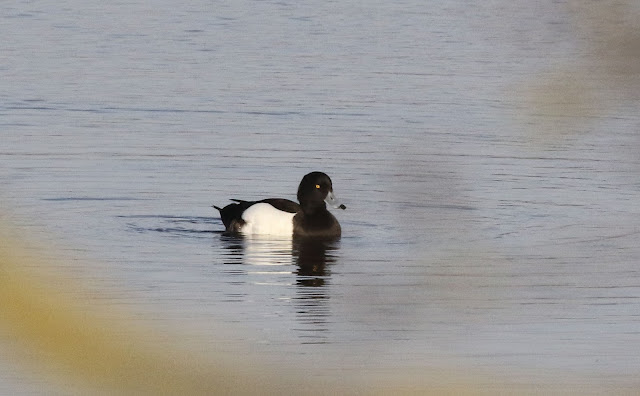






















































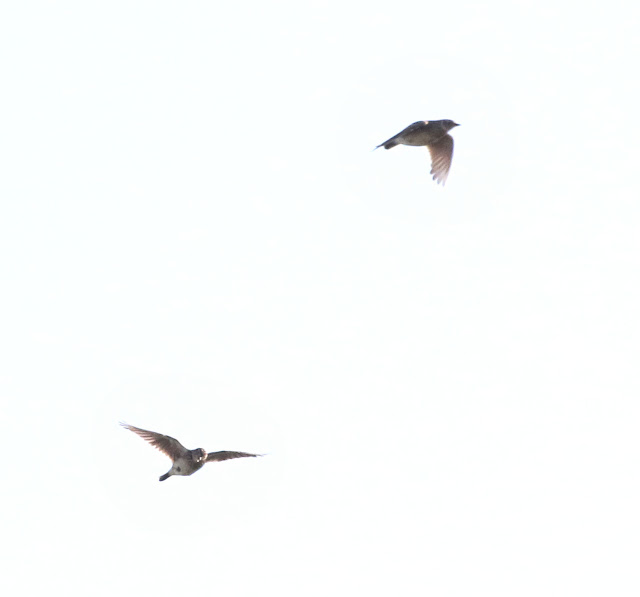









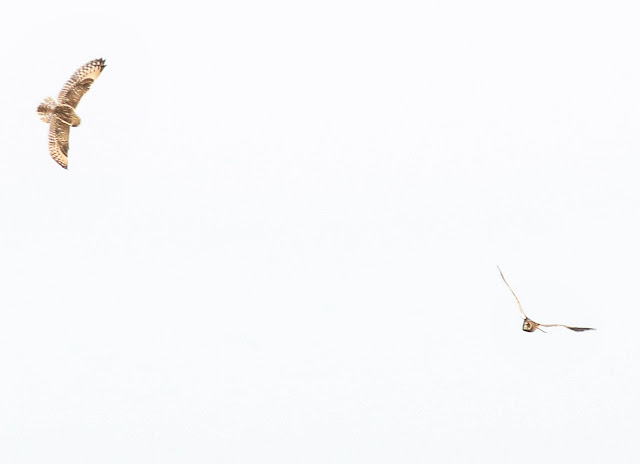



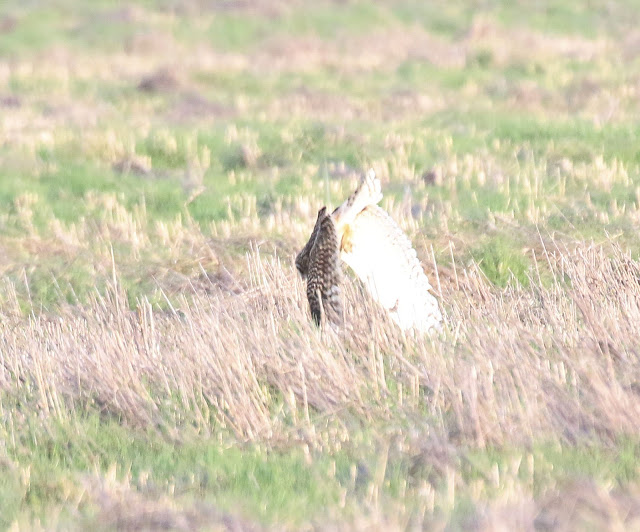




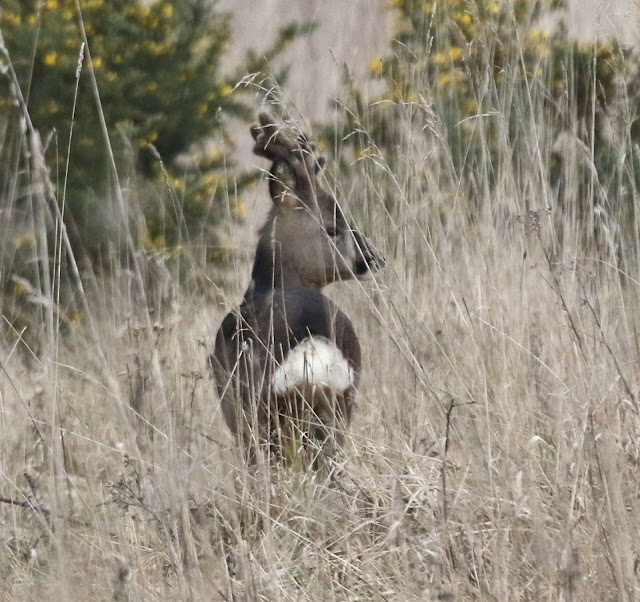



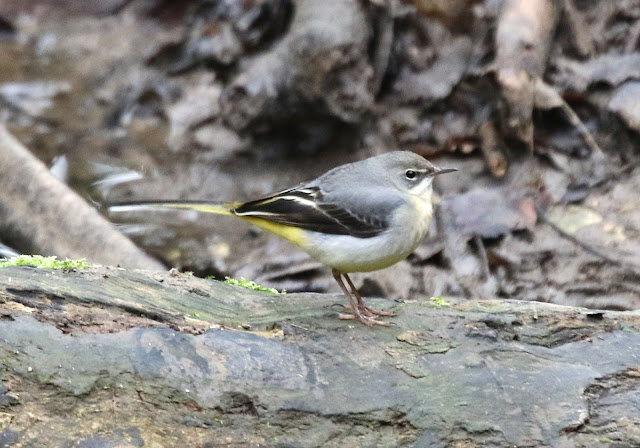










No comments:
Post a Comment